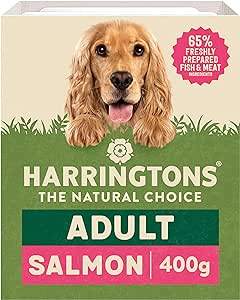
As a dog owner, I’ve often wondered: can dogs eat salmon? The answer is a resounding yes! My dog, Max, loves it when I share a bit of my dinner with him, but I always want to make sure I’m giving him something healthy and safe. If you’re like me, you probably have questions about what types of salmon are safe for dogs, the potential risks, and the best ways to serve it up. In this article, we’ll dive into the wonderful world of salmon and dogs, exploring all the ins and outs to ensure your furry friend gets the best out of this delicious fish.
Thank you for reading this post, don't forget to subscribe!Nutritional Benefits of Salmon Skin
High in Omega-3 Fatty Acids
Salmon skin is rich in omega-3 fatty acids, which are incredibly beneficial for dogs. These fatty acids help keep your dog’s skin and coat healthy and shiny. They also have anti-inflammatory properties that can benefit dogs with joint issues or arthritis.
Personal Anecdote: My Golden Retriever, Max, used to have a dull coat and occasional itchy skin. After incorporating omega-3-rich foods like salmon skin into his diet, his coat became much shinier, and his itching reduced significantly.

Protein Source
Protein is an essential part of a dog’s diet, and salmon skin is a great source of it. It helps in building and repairing tissues and provides the energy your dog needs for their daily activities.
Vitamins and Minerals
Salmon skin contains essential vitamins and minerals such as B vitamins, selenium, and potassium. These nutrients are vital for your dog’s overall health, supporting everything from energy production to immune function.

Types of Salmon Safe for Dogs
Cooked Salmon
Cooked salmon is an excellent addition to a dog’s diet. It’s essential to remove any bones or skin, as they can cause obstruction or splintering. I like to serve Max cooked salmon as an occasional treat or mix it into his regular meals for added nutrition.
Canned Salmon
Canned salmon in water or olive oil is another great option. Look for products with no added salt or seasonings, and be sure to drain the liquid before serving. Max loves when I mix canned salmon into his kibble – it’s like a little surprise!

Sashimi-Grade Salmon
Raw, sashimi-grade salmon is safe for dogs to eat, but it’s crucial to handle it safely to avoid bacterial contamination. If you choose to feed your dog raw salmon, ensure it’s from a trusted source and handle it with clean hands and utensils.
Potential Risks of Feeding Salmon Skin to Dogs
Risk of Parasites and Bacteria
One of the main concerns with feeding dogs salmon skin is the risk of parasites and bacteria, especially if the salmon is raw. Raw salmon can contain parasites like Neorickettsia helminthoeca, which can cause salmon poisoning disease in dogs.
Safety Tip: Always cook salmon skin thoroughly before feeding it to your dog to eliminate any harmful parasites and bacteria.
High Fat Content
Salmon skin is quite fatty, and while fats are necessary for your dog’s diet, too much can lead to issues like pancreatitis. Moderation is key when feeding your dog salmon skin.
Allergic Reactions
Some dogs may be allergic to salmon. It’s crucial to introduce any new food gradually and monitor your dog for any signs of an allergic reaction, such as itching, swelling, or digestive issues.
When is Salmon Unsafe for Dogs?
Salmon can be harmful if it’s prepared with ingredients that are toxic to dogs, such as garlic, onions, or excessive salt. Additionally, smoked salmon should be avoided due to its high sodium content and potential presence of harmful preservatives.
Avoid: Never give your dog smoked salmon, seasoned salmon, or salmon with bones, as these can pose serious health risks.
How to Safely Feed Salmon Skin to Dogs
Cooking Methods
Cooking salmon skin properly is essential to ensure it’s safe for your dog. You can bake, grill, or boil the skin, but make sure it’s cooked thoroughly without any added seasonings or oils. Learn the best recipe to cook salmon for your Dog
Recipe Idea: Bake salmon skin in the oven at 350°F (175°C) for about 15-20 minutes until it’s crispy. This method ensures that any harmful bacteria are killed, and the skin becomes a tasty treat for your dog.
Portion Control
While salmon skin can be a healthy addition to your dog’s diet, it’s important to feed it in moderation. Too much can lead to weight gain or digestive issues.
Guideline: For small breeds, a small piece of salmon skin once or twice a week is sufficient. For larger breeds, you can offer a slightly larger portion but still keep it to a few times a week.
Monitoring and Introducing New Foods
Whenever you introduce a new food to your dog’s diet, do it gradually. Start with a small piece of salmon skin and monitor your dog for any adverse reactions. If your dog shows any signs of discomfort or allergies, discontinue feeding and consult your veterinarian.
Alternatives to Salmon Skin
Commercial Dog Treats
If you’re not comfortable preparing salmon skin at home, there are plenty of commercial dog treats made from salmon skin available on the market. These treats are often dried and free from harmful additives, making them a convenient and safe option.
Other Safe Fish Options
Salmon isn’t the only fish that can benefit your dog. Other fish like mackerel, sardines, and herring are also rich in omega-3 fatty acids and can be a great addition to your dog’s diet.
Comparison: Sardines, for example, are smaller and can be fed whole to your dog. They are also less likely to contain the high levels of mercury found in larger fish like tuna.
Conclusion
Feeding your dog salmon skin can be a healthy and delicious treat, as long as it’s done safely and in moderation. The benefits of omega-3 fatty acids, protein, and essential nutrients can significantly improve your dog’s overall health. However, it’s crucial to be aware of the potential risks and to prepare salmon skin properly to avoid any health issues.
Final Tip: Always consult with your veterinarian before introducing new foods into your dog’s diet, especially if your dog has any pre-existing health conditions or dietary restrictions.
FAQs
Can dogs eat salmon skin raw?
No, dogs should not eat raw salmon skin due to the risk of parasites and bacteria. Always cook the salmon skin thoroughly before feeding it to your dog.
How often can I feed my dog salmon skin?
Salmon skin should be fed in moderation. For small breeds, a small piece once or twice a week is sufficient. Larger breeds can have slightly larger portions a few times a week.
What are the signs of an allergic reaction in dogs?
Signs of an allergic reaction in dogs include itching, swelling, hives, digestive issues, and in severe cases, difficulty breathing. If you notice any of these signs, stop feeding salmon skin and consult your veterinarian.
Are there any specific breeds that should avoid salmon skin?
While most breeds can enjoy salmon skin in moderation, dogs with a history of pancreatitis or those prone to weight gain should avoid high-fat foods like salmon skin. Always consult with your veterinarian for personalized advice.
Can puppies eat salmon skin?
Yes, puppies can eat salmon skin, but it should be introduced gradually and in small amounts. Ensure it is thoroughly cooked and free from any seasonings or harmful additives.
Personal Note: I remember the first time I gave my dog, Max, a piece of cooked salmon skin. His eyes lit up, and he wagged his tail with excitement. Since then, it’s become a special treat that he looks forward to, and I enjoy knowing that I’m giving him something both delicious and nutritious.

